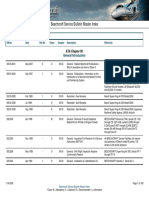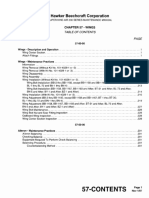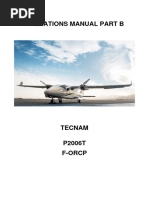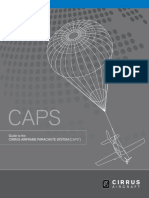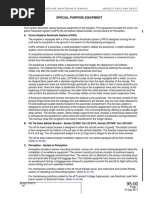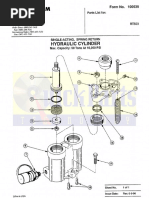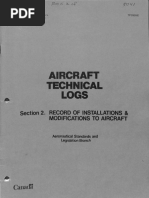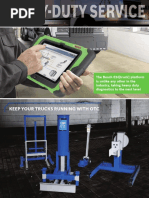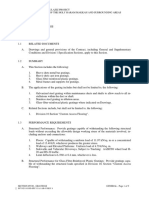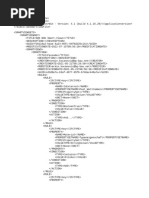Airworthiness Directive Schedule: Aeroplanes Beechcraft 200 Series (Super King Air) 28 August 2014
Airworthiness Directive Schedule: Aeroplanes Beechcraft 200 Series (Super King Air) 28 August 2014
Uploaded by
Fayçal MahieddineCopyright:
Available Formats
Airworthiness Directive Schedule: Aeroplanes Beechcraft 200 Series (Super King Air) 28 August 2014
Airworthiness Directive Schedule: Aeroplanes Beechcraft 200 Series (Super King Air) 28 August 2014
Uploaded by
Fayçal MahieddineOriginal Title
Copyright
Available Formats
Share this document
Did you find this document useful?
Is this content inappropriate?
Copyright:
Available Formats
Airworthiness Directive Schedule: Aeroplanes Beechcraft 200 Series (Super King Air) 28 August 2014
Airworthiness Directive Schedule: Aeroplanes Beechcraft 200 Series (Super King Air) 28 August 2014
Uploaded by
Fayçal MahieddineCopyright:
Available Formats
Airworthiness Directive Schedule
Aeroplanes
Beechcraft 200 Series (Super King Air)
28 August 2014
Notes 1. This AD schedule is applicable to Beechcraft 200, 200C, B200, B200C and B200GT
aircraft manufactured under Federal Aviation Administration (FAA) Type Certificate
No. A24CE.
2. The date above indicates the amendment date of this schedule.
3. New or amended ADs are shown with an asterisk *
Contents
DCA/B200/1 Flight Control System Rigging – Inspection and Rework .................................................. 2
DCA/B200/2 Cancelled – DCA/B200/11 refers ...................................................................................... 2
DCA/B200/3A Airworthiness Directive Compliance .................................................................................. 2
DCA/B200/4 Cancelled – DCA/B200/9 refers ........................................................................................ 3
DCA/B200/5 Wing Fuel Bay Skin Panels – Inspection........................................................................... 3
DCA/B200/6 Engine Controls Cross Shaft & Pedestal – Inspection and Modification ........................... 5
DCA/B200/7 Nose Landing Gear Fork – Inspection and Modification................................................... 6
DCA/B200/8 Aft Fuselage Stringers – Inspection and Modification ....................................................... 6
DCA/B200/9 Wing Attachment Bolts & Nuts – Inspection and Replacement ......................................... 8
DCA/B200/10 Cabin Door – Inspection and Rework................................................................................ 9
DCA/B200/11 Pneumatic Deicing System – Placard and Tube Replacement ......................................... 9
Issued 28 August 2014 Page 1 of 10 CAA of NZ
Aeroplanes Beechcraft 200 Series (Super King Air)
DCA/B200/1 Flight Control System Rigging – Inspection and Rework
Applicability: Model B200 aircraft, S/N BB-1827 through to BB-1912.
Model B200C aircraft, S/N BL-148 and BL-149.
Requirement: To detect and correct improperly assembled or damaged flight controls which could
result in reduced capabilities of the flight controls and lead to loss of aircraft control,
inspect the entire flight control system for improper assembly and damage, per the
instructions in Raytheon Aircraft Company Mandatory Service Bulletin (MSB) No.SB
27-3761, revision 1.
Repair all improperly assembled or damaged flight controls per MSB No.SB 27-3761,
before further flight.
(FAA AD 2007-12-06 refers)
Compliance: Within the next 100 hours TIS or next annual inspection, whichever occurs sooner,
unless already accomplished.
Effective Date: 29 November 2007
DCA/B200/2 Cancelled – DCA/B200/11 refers
Effective Date: 24 February 2010
DCA/B200/3A Airworthiness Directive Compliance
Applicability: All model 200, 200C, B200 and B200C series aircraft.
Note 1: Revision A of this AD revised to include Beech 200 and 200C series aircraft in the
applicability and include those FAA ADs applicable to these aircraft.
Requirement: Compliance with the following FAA Airworthiness Directives (as applicable) is
required:
1974-24-03 Strobe Light System
1975-14-03 Autopilot
1975-25-01 Generator Output Leads
1975-26-04 Fuel Transfer System
1976-03-07 Rudder Control
1976-04-02 Seat Locking Pins
1976-09-02 Bolt Hole Edge Distance
1976-12-10 Wiring Deicing
1976-22-02R1 Y Type Shoulder Harness
1977-02-07 Propeller Feathering
1977-13-07 Aileron Control System
1977-18-04 Cabin Pressurization
1979-01-01 Screws in Control System
1980-07-05 Wing Section Bolt and Nut
1980-09-03R1 Oxygen Placard
1983-07-14 One-ply Window
1987-04-24 Elevator Trim Cable System
1989-02-03 Wing Main Outboard Spars
1989-22-14 Ailerons
1990-08-17 Moisture Drain System
1991-12-10 Wing Spar Attachment
1991-12-11 Windows
1992-06-11 Erroneous Attitude Information
1992-10-12 Aft Cowling Doors
1992-15-01 Truss/Firewall Bolts
1995-13-03 Landing Gear Motor
1996-03-13 Main Landing Gear
1996-09-13 Icing Conditions
Issued 28 August 2014 Page 2 of 10 CAA of NZ
Aeroplanes Beechcraft 200 Series (Super King Air)
1997-01-12 GPWS Equipment
1997-06-06 Pilot and Copilot Seat
1997-23-17 Tubing Inspection
1997-25-01 Outflow/Safety Valve
1997-25-03 AFM Limitations
1998-10-05 Fire Resistant Wiring
1998-20-38R1 AFM Revision – Severe Icing Conditions
1998-21-35 MLG Actuator Clevis Assembly
1999-09-10 Landing Gear Hand Pump
1999-09-15 Flight Control Mechanism
1999-18-15 Landing Gear Emergency Hand Pumps
2001-11-03 Blower Motor Circuit Protection
2002-23-11 Balance Weight Attach Screws
2003-02-03 Operating Instructions
2003-13-16 Aft Fuselage Pressure Bulkhead
2005-01-04 Fuel Flow Interruption
2006-12-25 MLG Actuator Nut Assembly
Note 2: Each part of this AD (each individual FAA AD) shall be certified in the aircraft log book
separately.
Compliance: Before issue of a New Zealand Certificate of Airworthiness or at the next ARA
inspection after the effective date of this AD, whichever is the sooner.
Effective Date: DCA/B200/3 - 26 March 2009
DCA/B200/3A - 29 October 2009
DCA/B200/4 Cancelled – DCA/B200/9 refers
Effective Date: 29 October 2009
DCA/B200/5 Wing Fuel Bay Skin Panels – Inspection
Applicability: Model 200 and B200 aircraft, S/N BB-2 through to BB-1362), and
Model 200C and B200C aircraft, S/N BL-1 through to BL-135), and
Model 200CT and B200CT aircraft, S/N BN-1 through to BN-4, and
Model 200T and B200T aircraft, S/N BT-1 through to BT-33, and
Fitted with wing fuel bay upper skin panels made with bonded (aluminum honeycomb
sandwich) construction.
Note 1: Aircraft with S/N BB-2 through to BB-613, BT-1 through to BT-17, BT-19 and BL-1
through BL-6 were manufactured with a skin-and-stringer construction and are not
affected by this AD unless bonded wing fuel bay upper skin panels were fitted after
manufacture.
Requirement: To ensure the continued structural integrity of the wing fuel bay upper skin panels,
accomplish the following:
1. Inspect the aircraft logbooks or inspect the wing fuel bay upper skin panels
(hereafter called "skin panels") for possible bonded (honeycomb sandwich)
construction.
2. For aircraft fitted with bonded skin panels with blind rivets as shown in the
shaded portions of figure 2 in the SB No. 2040:
Inspect the skin panels for debonding per Beech SB No. 2040 revision III dated April
1990.
Issued 28 August 2014 Page 3 of 10 CAA of NZ
Aeroplanes Beechcraft 200 Series (Super King Air)
If the skin panel has previously been repaired per Beech Kit No. 101-4032-1S or 101-
4032-3S and debonding is found, fit an approved partial replacement panel per Kit
Nos. 101-4045-3S (LH) and 101-4045-4S (RH) before further flight.
If the skin panel has previously been repaired per Beech Kit No. 101-4032-1S or 101-
4032-3S and debonding is not found reseal the blind rivets per Beech Kit 101-4048-
1S.
If the skin panel has previously not been repaired and debonding is found, either fit an
approved partial replacement panel per Kit Nos. 101-4045-3S (LH) and 101-4045-4S
(RH) before further flight, or fit a temporary repair per figure 1 of Beech SB No. 2040
before further flight. The temporary repair can only remain in service for 12 calendar
months from the time of repair, at which time an approved partial replacement panel
per Kit Nos. 101-4045-3S (LH) and 101-4045-4S must be fitted.
If the skin panel has previously not been repaired and debonding is not found, reseal
the blind rivets per Beech Kit No. 101-4048-1S and reinspect the skin panel for
debonding within 6 calendar months, again within another 12 calendar months, and at
18 calendar months or 600 hour TIS intervals thereafter, whichever occurs first.
Note 2: No further AD action is required for skin panels modified per Beech Kit No. 101-4032-
1S or 101-4032-3S. These panels are bonded with Nomex honeycomb core and do
not have rivets.
3. For aircraft fitted with bonded skin panels which do not have blind rivets as
shown in the shaded portions of figure 2 in the SB No. 2040:
Inspect the skin panels for debonding per Beech SB No. 2040 revision III dated April
1990.
If debonding is found, either fit an approved partial replacement panel per Kit Nos.
101-4045-3S (LH) and 101-4045-4S (RH) before further flight, or fit a temporary
repair per figure 1 of Beech SB No. 2040 before further flight. The temporary repair
can only remain in service for 12 calendar months from the time of repair, at which
time an approved partial replacement panel per Kit Nos. 101-4045-3S (LH) and 101-
4045-4S must be fitted.
Note 3: The following aircraft were manufactured with bonded skin panels without rivets:
Model B200 aircraft, S/N BB-1239 onward and model B200C aircraft, S/N BL-127.
(FAA AD 1989-19-04R1 refers)
Compliance: 1. By 26 April 2009 unless previously accomplished.
2. Within the next 150 hours TIS or by 26 September 2009, whichever occurs
sooner.
Thereafter if the skin panel has previously been repaired per Beech Kit No. 101-4032-
1S or 101-4032-3S and if debonding is not found inspect the skin panel for
debonding within the next 6 months, again within another 12 months and at 18
months or at 600 hour TIS whichever occurs sooner.
Thereafter if the skin panel has previously not been repaired and debonding is not
found, reseal the blind rivets per Beech Kit No. 101-4048-1S inspect the skin panel
for debonding within the next 6 months, again within another 12 months, and at 18
months or 600 hour TIS whichever occurs sooner.
3. Within the next 600 hours TIS or by 26 September 2010, whichever occurs
sooner and thereafter if debonding is not found inspect the skin panel for debonding
at intervals not to exceed 18 months.
Effective Date: 26 March 2009
Issued 28 August 2014 Page 4 of 10 CAA of NZ
Aeroplanes Beechcraft 200 Series (Super King Air)
DCA/B200/6 Engine Controls Cross Shaft & Pedestal – Inspection and Modification
Applicability: Model 200 and B200 aircraft, S/N BB–6 through to BB–185, BB–187 through to BB–
202, BB–204 through to BB–269, BB–271 through to BB–407, BB–409 through to
BB–468, BB–470 through to BB–488, BB–490 through to BB–509, BB–511 through to
BB–529, BB–531 through to BB–550, BB–552 through to BB–562, BB–564 through to
BB–572, BB–574 through to BB–590, BB–592 through to BB–608, BB–610 through to
BB–626, BB–628 through to BB–646, BB–648 through to BB–664, BB–666 through to
BB–694, BB–696 through to BB–797, BB–799 through to BB–822, BB–824 through to
BB–870, BB–872 through to BB–894, BB–896 through to BB–990, BB–992 through to
BB–1051, BB–1053 through to BB–1092, BB–1094, BB–1095, BB–1099 through to
BB–1104, BB–1106 through to BB–1116, BB–1118 through to BB–1184, BB–1186
through to BB–1263, BB–1265 through to BB–1288, BB–1290 through to BB–1300,
BB–1302 through to BB–1313, BB–1315 through to BB–1384, BB–1389 through to
BB–1425, BB–1427 through to BB–1447, BB–1449, BB–1450, BB–1452, BB–1453,
BB–1455, BB–1456, BB–1458 through to BB–1683, BB–1685 through to BB–1716,
BB–1718 through to BB–1720, BB–1722, BB–1723, BB–1725, BB–1726, BB–1728
through to BB–1826.
Model 200C and B200C aircraft, S/N BL–1 through to BL–23, BL–25 through to BL–
57, BL–61 through to BL–72, and BL–124 through to BL–147.
Requirement: To detect and correct loose pedestal cross shaft bolts, which could result in limited
effectiveness of the control levers, accomplish the following:
1. Inspect the engine controls/cross shaft/pedestal for proper installation and the
torque of the cross attach bolt per the instructions in part I of Raytheon Aircraft
Company MSB No. SB 73–3634, dated September 2003 and the applicable aircraft
maintenance manual.
If the installation or torque is found incorrect, accomplish the corrective actions per
the instructions in part I of MSB No. SB 73–3634 and the applicable aircraft
maintenance manual before further flight.
2. Modify the pedestal and replace the engine controls cross shaft hardware per
the instructions in part II of MSB No. SB 73–3634 and the applicable aircraft
maintenance manual.
Note: The accomplishment of requirement 2 of this AD is a terminating action for the
repetitive inspection and retorque of requirement 1.
(FAA AD 2004-17-02 refers)
Compliance: 1. Within the next 50 hours TIS unless previously accomplished and thereafter at
intervals not to exceed 100 hours TIS until accomplishment of requirement 2 of this
AD.
2. At the next scheduled maintenance inspection or by 26 March 2010 whichever
occurs later, unless previously accomplished.
Effective Date: 26 March 2009
Issued 28 August 2014 Page 5 of 10 CAA of NZ
Aeroplanes Beechcraft 200 Series (Super King Air)
DCA/B200/7 Nose Landing Gear Fork – Inspection and Modification
Applicability: Model 200 and B200 aircraft, S/N BB–2 and BB–6 through to BB–1314.
Model 200C and B200C aircraft, S/N BL–1 through to BL–72, and BL–124 through to
BL–131.
Model B200C (C–12F) aircraft, S/N BL–73 through to BL–112, BL–118 through to
BL–123, and BP–64 through to BP–71.
Model B200C (UC–12F) aircraft, S/N BU–1 through to BU–10.
Model B200C (UC–12M) aircraft, S/N BV–1 through to BV–10.
Note 1: This AD is not applicable to aircraft embodied with Kit No. 101–8030–1S or Kit No.
114–8015–1S, as applicable.
Requirement: To prevent failure of the nose landing gear (NLG) fork due to possible cracks which
could result in reduced structural integrity and inability of the NLG fork to carry design
limit and ultimate loads, accomplish the following:
Inspect the NLG fork assembly for cracks using a fluorescent liquid penetrant or
magnetic particle method per the instructions in part II of Raytheon Aircraft Company
MSB SB 32–2102 revision 7 dated July 2003.
If any cracks are found embody Kit No. 101–8030–1S or Kit No. 114–8015–1S as
applicable per part II of MSB SB 32–2102 before further flight.
Note 2: Embodying Kit No. 101–8030–1S or Kit No. 114–8015–1S as applicable, is the
terminating action for the repetitive inspection requirements of this AD.
(FAA AD 2004-23-02 refers)
Compliance: Within the next 200 hours TIS unless previously accomplished, and thereafter at
intervals not to exceed 200 hours TIS until Kit No. 101–8030–1 S or Kit No. 114–
8015–1 S as applicable, is embodied.
Effective Date: 26 March 2009
DCA/B200/8 Aft Fuselage Stringers – Inspection and Modification
Applicability: Model 200 and B200 aircraft, S/N BB–2 and BB–6 through to BB–1462
Model 200C and B200C aircraft, S/N BL–1 through to BL–72 and BL–124 through to
BL–138
Model B200C (C–12F) aircraft, S/N BL–73 through to BL–112 and BL–118 through to
BL–123
Model B200C (C–12F) aircraft, S/N BP–64 through to BP–71
Model B200C (UC–12F) aircraft, S/N BU–1 through to BU–10
Model B200C (UC–12M) aircraft, S/N BV–1 through to BV–12
Note 1: This AD introduces the mandatory modification/repair of aircraft with known cracks in
the aft fuselage stringer locations No. 5 through to No. 11. These cracks would have
been detected through previous compliance with FAA AD 93–25–07 and/or Raytheon
MSB SB 53–2472.
Issued 28 August 2014 Page 6 of 10 CAA of NZ
Aeroplanes Beechcraft 200 Series (Super King Air)
Requirement: To prevent failure of the primary structure of the fuselage which could result in loss of
the aircraft control, accomplish the following:
1. For aircraft with known cracks in the aft fuselage stringer locations No. 5 through
to No. 11 on both the left-hand and right-hand sides of the aircraft:
Embody the applicable modification kit or kits per Raytheon MSB SB 53–2472
revision 4, dated June 1993, revised July 2003, or
Fit external doubler repairs on all the aft fuselage stringer locations No. 5 through to
No. 11 on both the left-hand and right-hand sides of the aircraft per the procedures in
the aircraft maintenance manual.
2. For aircraft without the applicable modification kit or kits embodied and aircraft
without external doubler repairs accomplished in the aft fuselage stringer locations
No. 5 through to No. 11 on both the left-hand and right-hand sides of the aircraft:
Inspect the aft fuselage stringers for cracks per Raytheon MSB SB 53–2472. If
sealant covers the stringers, remove the sealant to accomplish the required
inspections. If no cracks are found, reapply the sealant before further flight.
If any cracks are found, embody the applicable modification kit or kits per Raytheon
MSB SB 53–2472 before further flight, or
Fit external doubler repairs on all the aft fuselage stringer locations No. 5 through to
No. 11 on both the left-hand and right-hand sides of the aircraft per the procedures in
the aircraft maintenance manual before further flight.
Note 2: Embodying the applicable modification kit or kits per Raytheon MSB SB 53–2472 to
all aft fuselage stringer locations No. 5 through to No. 11 on both the left-hand and
righthand sides of the aircraft is a terminating action to requirement 2 of this AD.
(FAA AD 2005-01-18 refers)
Compliance: 1. For aircraft with less than five known cracked stringers:
Within the next 25 cycles, unless previously accomplished.
For aircraft with five or more known cracked stringers:
Before further flight, unless previously accomplished.
2. At 2500 cycles or within the next 25 cycles whichever occurs later, unless
previously accomplished, and thereafter at intervals not to exceed 500 cycles.
Note 3: For aircraft with unknown cycles, divide the hours TIS by 0.75 (eg. 18.75 hours TIS
divided by 0.75 = 25 cycles).
Effective Date: 26 March 2009
Issued 28 August 2014 Page 7 of 10 CAA of NZ
Aeroplanes Beechcraft 200 Series (Super King Air)
DCA/B200/9 Wing Attachment Bolts & Nuts – Inspection and Replacement
Applicability: Model 200, 200C, B200 and B200C aircraft listed in the following table:
Aircraft Models: Aircraft S/N: Joints: Instructions:
200 BB344 through to BB-983 LF, UF P/N 98-39006
B200 BB-985 thru BB-1038 LF,UF P/N 98-39006
B200 BB-1040 thru BB-1045 LF,UF P/N 98-39006
BB-1047 thru BB-1049 LF,UF P/N 98-39006
BB-1053 thru BB-1078 & BB- LF,UF P/N 98-39006
1080 LF,UF P/N 98-39006
200C and B200C BL-1 thru BL-51 LF,UF P/N 98-39006
Note 1: This AD supersedes DCA/B200/4 and includes Beech 200 aircraft in the applicablity.
Note 2: This AD is not applicable to aircraft fitted with wing attachment bolts and nuts made of
Inconel.
Note 3: Wing attachments on the left and right sides of the aircraft are abbreviated as:
LF=lower forward and UF=upper forward.
Requirement: To ensure the structural integrity of outer wing panels to the wing center section
attachments, use the Structural Inspection and Repair Manual No. 98-39006 to
accomplish the following requirements at each wing attachment specified in the table
of this AD:
1. Outer Wing Panel to Wing Center Section Attachment Inspection:
Remove each steel nut and each steel tension bolt and accomplish a visual
inspection and a magnetic particle inspection of the bolt and nut for cracks and
corrosion in the parent steel. Replace bolts and nuts which are cracked or corroded.
With the reassembly of each joint, coat the bolt, nut and adjacent parts with MIL- C-
16173 Grade 2 corrosion preventative compound.
2. Joint Tightness Inspection:
Inspect each joint for tightness and tighten bolts/nuts as required, and inject MIL-C-
16173 Grade 2 corrosion preventative compound into a lubrication fitting on each
barrel nut, (wherever a barrel nut is used).
(FAA AD 1985-22-05 refers)
Compliance: 1. Within 60 months after the issue of the original airworthiness certificate or by 29
December 2009 whichever is the later, and thereafter at intervals not to exceed 60
months.
2. Within the next 150 hours TIS after accomplishment of requirement 1 of this AD
and thereafter at intervals not to exceed 12 months inject MIL-C-16173 Grade 2
corrosion preventative compound into a lubrication fitting on each barrel nut,
(wherever a barrel nut is used).
Effective Date: 29 October 2009
Issued 28 August 2014 Page 8 of 10 CAA of NZ
Aeroplanes Beechcraft 200 Series (Super King Air)
DCA/B200/10 Cabin Door – Inspection and Rework
Applicability: Model 200 aircraft, S/N BB-2 through to BB-111
Requirement: To prevent the cabin door from opening in flight, accomplish the following:
1. Inspect the cabin door for correct operation and rigging in accordance with the
applicable Beech Shop/Maintenance Manual. When all the items specified in
Paragraph II have been complied with the requirements of this paragraph (I) are no
longer applicable.
2. Accomplish the following instruction in accordance with Beechcraft Service
Instruction 0818-016 or later FAA approved revisions:
Install Beech P/N 101-430124-1 and fix step door decals Beech P/N 101-430124-3 or
-5 on the existing cabin door instruction plate.
Check the operation of the cabin door. Inspect the cabin door latching mechanism
and warning system for proper operation and rigging in accordance with the
applicable Beech Shop/Maintenance Manual.
Amend the AFM and include FAA approved Beech P/N 101-590010-3A4 AFM
supplement revision dated 14 November 1975 or later FAA approved revisions.
(FAA AD 1976-10-10 refers)
Compliance: 1. Within the next 50 hours TIS and thereafter at intervals not to exceed 50 hours
TIS until requirement 2 of this AD is accomplished.
2. By 29 December 2010 unless previously accomplished.
Effective Date: 29 October 2009
DCA/B200/11 Pneumatic Deicing System – Placard and Tube Replacement
Applicability: Model B200 aircraft, S/N BB-1926, BB-1978 and BB-1988 through to BB-2000
Model B200GT aircraft, S/N BY-1 through to BY-26
Note 1: This AD retains the requirements in superseded DCA/B200/2 and introduces Hawker
Beechcraft MSB SB 30-3889 revision 1, dated October 2010 which requires
additional actions.
Requirement: To prevent the collapse of the tail deice boots pneumatic supply tubes possibly
resulting in the tail deice boots failing to operate which could result in loss of aircraft
control in icing conditions, accomplish the following:
1. Fabricate a placard (using at least 1/8-inch letters) with the following text and
install the placard on the instrument panel within the pilot's clear view: “THIS
AIRCRAFT IS PROHIBITED FROM FLIGHT IN KNOWN OR FORECAST ICING.”
Note 2: Requirement 1 of this AD may be performed and certified under the provision in Part
43 Appendix A.1 (7) by the holder of a current pilot licence, if that person is rated on
the aircraft, appropriately trained and authorised (Part 43, Subpart B refers), and the
maintenance is recorded and certified as required by Part 43.
2. Replace the tail deice boots pneumatic supply tubing from the rear spar at
Fuselage Station (FS) 227.00 to the aft pressure bulkhead at FS 347.750 with Hytrel
tubing part number P/N 131823VH10D-1210 and remove the placard on the
instrument panel. Accomplish these actions per the instructions in Hawker Beechcraft
MSB SB 30-3889 revision 1, dated October 2010.
Issued 28 August 2014 Page 9 of 10 CAA of NZ
Aeroplanes Beechcraft 200 Series (Super King Air)
If Hawker Beechcraft MSB no. SB 30-3889 issued March 2008 has already been
accomplished, then a new piece of Hytrel tubing may be spliced on the existing Hytrel
tubing in the aft evaporator bay area.
(FAA AD 2010-26-03 refers)
Compliance: 1. Before further flight in known or forecast icing conditions, or by 27 February
2011 whichever occurs sooner, unless previously accomplished.
2. Before further flight in known or forecast icing conditions, or within the next 25
hours TIS, or by 24 May 2011 whichever occurs sooner.
Effective Date: 24 February 2011
Issued 28 August 2014 Page 10 of 10 CAA of NZ
You might also like
- A House in The Rift v0.49r3 Scene Guide: LewdnessDocument4 pagesA House in The Rift v0.49r3 Scene Guide: LewdnessGuisbzNo ratings yet
- B200 Emergency ProceduresDocument18 pagesB200 Emergency ProceduresManuel Nieto100% (1)
- Bombardier Challenger 601-3AER 7pDocument7 pagesBombardier Challenger 601-3AER 7pNaili Bourhane Aboudou Rahime0% (1)
- Kidde Capabilities ListDocument34 pagesKidde Capabilities ListFayçal Mahieddine100% (1)
- Yerai Corts - Seguiriyas in Solera FlamencaDocument2 pagesYerai Corts - Seguiriyas in Solera FlamencaAntonio González AsencioNo ratings yet
- Flight Standardization Board (FSB) ReportDocument65 pagesFlight Standardization Board (FSB) ReportJuaco Zamb100% (1)
- Bell206 Emergency Procedure PDFDocument11 pagesBell206 Emergency Procedure PDFupali01No ratings yet
- Sealant Cross Reference: Prc/Desoto Flamemaster Chemseal Pro-Seal OtherDocument1 pageSealant Cross Reference: Prc/Desoto Flamemaster Chemseal Pro-Seal OtherFayçal Mahieddine0% (2)
- India International CentreDocument20 pagesIndia International CentreAnoop Sharma64% (14)
- Manual Ventilador InglesDocument24 pagesManual Ventilador InglesCeCy UMNo ratings yet
- Introduction to Fly-by-Wire Flight Control Systems: The professional pilot’s guide to understanding modern aircraft controlsFrom EverandIntroduction to Fly-by-Wire Flight Control Systems: The professional pilot’s guide to understanding modern aircraft controlsNo ratings yet
- FAR-AMT 2025: Federal Aviation Regulations for Aviation Maintenance TechniciansFrom EverandFAR-AMT 2025: Federal Aviation Regulations for Aviation Maintenance TechniciansNo ratings yet
- Airman Certification Standards: Airline Transport Pilot and Type Rating - Airplane (2025): FAA-S-ACS-11AFrom EverandAirman Certification Standards: Airline Transport Pilot and Type Rating - Airplane (2025): FAA-S-ACS-11ANo ratings yet
- Hawker 800xp SpecsDocument5 pagesHawker 800xp SpecsCooper L100% (2)
- Pilots' Checklist: Nav Ill Avionics OptionDocument62 pagesPilots' Checklist: Nav Ill Avionics OptionGustavo Avila Rodriguez100% (1)
- 675 - S&D CessnaDocument25 pages675 - S&D CessnaBasuki RahardjoNo ratings yet
- CE560 Note Taking Guide v1.12Document20 pagesCE560 Note Taking Guide v1.12loicfrevilleNo ratings yet
- 129-590000-7 Normal Procedures B1900dDocument34 pages129-590000-7 Normal Procedures B1900dHernan RomeroNo ratings yet
- Pilot SafetyDocument120 pagesPilot SafetyamilaNo ratings yet
- JAR-FCL 1 Sec 2Document220 pagesJAR-FCL 1 Sec 2Doru VarlanNo ratings yet
- Progressive 50 Hour Inspection PA-42 / 42-720 Cheyenne III Cheyenne IIIADocument60 pagesProgressive 50 Hour Inspection PA-42 / 42-720 Cheyenne III Cheyenne IIIALeoNo ratings yet
- Cap. 4 - ICE AND RAIN PROTECTION SYSTEM GENERAL INFORMATIONDocument23 pagesCap. 4 - ICE AND RAIN PROTECTION SYSTEM GENERAL INFORMATIONtanaure100% (3)
- KA B200 & B200C Pilot ChecklistDocument118 pagesKA B200 & B200C Pilot ChecklistLucas Carvalho PioNo ratings yet
- Faa-Approved Pilot'S Operating Handbook and Airplane Flight Manual Supplement For TheDocument160 pagesFaa-Approved Pilot'S Operating Handbook and Airplane Flight Manual Supplement For TheBurnerNo ratings yet
- Beechcraft B200 POH - 01. Normal ProceduresDocument34 pagesBeechcraft B200 POH - 01. Normal ProceduresAgustinNo ratings yet
- Bendix Fuel Injection Training ManualDocument25 pagesBendix Fuel Injection Training ManualRicardo zafra100% (1)
- Aaa TM c560xls App 2 SopDocument35 pagesAaa TM c560xls App 2 SopSlobodan Tesanovic100% (1)
- Beechcraft Service Bulletin Master Index: ATA Chapter 00Document188 pagesBeechcraft Service Bulletin Master Index: ATA Chapter 00GabrielArriondaNo ratings yet
- Hawker 00XPC LimitationsDocument31 pagesHawker 00XPC LimitationsAngel Abraham Guerrero GarzaNo ratings yet
- PA-31T ChecklistDocument11 pagesPA-31T ChecklistRaph 1123No ratings yet
- PT6A Séries - Training ManualDocument12 pagesPT6A Séries - Training ManualRafael Alves Dos Santos100% (1)
- Pa42 QRH 2 PerDocument20 pagesPa42 QRH 2 PerAnonymous ib89TV100% (1)
- Gulfstream Turbo Commander 690C-840 - Gulfstream Turbo Commander 690C-840 Normal ChecklistpdfDocument28 pagesGulfstream Turbo Commander 690C-840 - Gulfstream Turbo Commander 690C-840 Normal ChecklistpdfEduardo Augusto De AraújoNo ratings yet
- Flight Safety C90GTX ChecklistDocument108 pagesFlight Safety C90GTX Checklistmarceloflyjs100% (2)
- Section - III Systems DescriptionDocument18 pagesSection - III Systems DescriptionJose LaraNo ratings yet
- Robinson R22 ChecklistDocument1 pageRobinson R22 ChecklistzachNo ratings yet
- MM Wing King Air 200Document31 pagesMM Wing King Air 200Franco Puga100% (1)
- Blackhawk XP135A Engine Upgrade King Air 90 SeriesDocument2 pagesBlackhawk XP135A Engine Upgrade King Air 90 SeriesjhNo ratings yet
- Avidyne EX5000 MFDDocument204 pagesAvidyne EX5000 MFDWBH VideosNo ratings yet
- UAS Engines: Reference SectionDocument3 pagesUAS Engines: Reference SectionMorgen GumpNo ratings yet
- Troubleshooting Tips For King Air AcDocument4 pagesTroubleshooting Tips For King Air AcΠαναγιωτης ΑποστολοπουλοςNo ratings yet
- Hawker 900XP Review Flight Global 2008Document10 pagesHawker 900XP Review Flight Global 2008albucurNo ratings yet
- ATA 24 - Cessna - Alternator Charging System 38-52-60 Amp Service - Parts Manual - D5107 - Rev 1 - 19930802Document127 pagesATA 24 - Cessna - Alternator Charging System 38-52-60 Amp Service - Parts Manual - D5107 - Rev 1 - 19930802Carlos Chavez Jaramillo100% (1)
- Kodiak 100 Floats A-33104 SpecificationsDocument60 pagesKodiak 100 Floats A-33104 Specificationsdrew boydNo ratings yet
- 226-227 Long Body CDLDocument12 pages226-227 Long Body CDLHonorio Perez MNo ratings yet
- 208comp 08 00Document133 pages208comp 08 00mothboy100% (1)
- FirebossDocument146 pagesFirebossMark Evan SalutinNo ratings yet
- Operating Manual P2006TDocument110 pagesOperating Manual P2006TAmin Tarverdi100% (1)
- Program Files/WS - FTP/astra: Jack SobelmanDocument32 pagesProgram Files/WS - FTP/astra: Jack SobelmanJose Lara100% (1)
- C208B Checklist Emergency Procedures Model 208BDocument46 pagesC208B Checklist Emergency Procedures Model 208BYash100% (1)
- Hawker 00XPC-Ice Protection SystemDocument14 pagesHawker 00XPC-Ice Protection SystembetochalNo ratings yet
- General Specifications. Performance - DimensionsDocument2 pagesGeneral Specifications. Performance - Dimensionslegoulu21No ratings yet
- CAPS Guide PDFDocument16 pagesCAPS Guide PDFBONFIRE100% (1)
- ZLIN AIRCRAFT - Airplanes - enDocument9 pagesZLIN AIRCRAFT - Airplanes - enFrancois MNo ratings yet
- Gas Turbines SpecsDocument11 pagesGas Turbines SpecsDiêgo MonteiroNo ratings yet
- Fms Afm SupplementDocument71 pagesFms Afm SupplementRedouane BelaassiriNo ratings yet
- Flight Manual Supp 208B-12JR - R5-11-7-19Document139 pagesFlight Manual Supp 208B-12JR - R5-11-7-19DennisNo ratings yet
- CJ2 Checklist 2021Document2 pagesCJ2 Checklist 2021remaja1249No ratings yet
- Aircraft TypeDocument1 pageAircraft TypeMahmoud Al-TamimiNo ratings yet
- Learjet 55 60 Windows WindshieldsDocument2 pagesLearjet 55 60 Windows WindshieldsHenry100% (1)
- Piper Seneca II Service Spares Letter - SSL 406Document22 pagesPiper Seneca II Service Spares Letter - SSL 406AlejandroNo ratings yet
- Piper Seminole Systems Oral QuestionsDocument2 pagesPiper Seminole Systems Oral QuestionsPatrick HerreraNo ratings yet
- PWR Lever - Close Prop Lever - Feather Condition Lever - Cutoff Engine Fire Switch - PushDocument11 pagesPWR Lever - Close Prop Lever - Feather Condition Lever - Cutoff Engine Fire Switch - PushNienke van SchijndelNo ratings yet
- Cirrus AMM 95-00Document22 pagesCirrus AMM 95-00Leandro CalientoNo ratings yet
- P180 Vs K350 PiaggioDocument2 pagesP180 Vs K350 Piaggiototality0% (1)
- Powerteamrt 503Document2 pagesPowerteamrt 503Fayçal MahieddineNo ratings yet
- Resume - Nicholas RehmDocument2 pagesResume - Nicholas RehmFayçal MahieddineNo ratings yet
- Aircraft Technical LogsDocument9 pagesAircraft Technical LogsFayçal MahieddineNo ratings yet
- 2005 1028-Bosch Otc Heavy Duty Flyer 10 13Document16 pages2005 1028-Bosch Otc Heavy Duty Flyer 10 13Fayçal Mahieddine100% (1)
- TCDS EASA - IM - .A.277 Issue 18Document41 pagesTCDS EASA - IM - .A.277 Issue 18Fayçal MahieddineNo ratings yet
- Baseops OffStation ChecklistDocument1 pageBaseops OffStation ChecklistFayçal MahieddineNo ratings yet
- Hydraulic CylinderDocument2 pagesHydraulic CylinderFayçal MahieddineNo ratings yet
- Abs Landing Gear Guide2Document60 pagesAbs Landing Gear Guide2Fayçal Mahieddine100% (1)
- Main Gear Retraction Loads Schematic - Q640Document1 pageMain Gear Retraction Loads Schematic - Q640Fayçal MahieddineNo ratings yet
- Compressor ThermodynamicsDocument1 pageCompressor ThermodynamicsFayçal MahieddineNo ratings yet
- Aircraft Landing Gear Design & DevelopmentDocument1 pageAircraft Landing Gear Design & DevelopmentFayçal MahieddineNo ratings yet
- Lean Blow Out Limits of A Gas Turbine CombustorDocument10 pagesLean Blow Out Limits of A Gas Turbine CombustorFayçal MahieddineNo ratings yet
- Reliability Analysis of Landing Gear Retraction SystemsDocument1 pageReliability Analysis of Landing Gear Retraction SystemsFayçal MahieddineNo ratings yet
- Landing Gear and BrakesDocument1 pageLanding Gear and BrakesFayçal MahieddineNo ratings yet
- Boeing 777 Landing Gear StructureDocument1 pageBoeing 777 Landing Gear StructureFayçal MahieddineNo ratings yet
- Landing Gear Wheels and TiresDocument1 pageLanding Gear Wheels and TiresFayçal MahieddineNo ratings yet
- Landing Gear A Multibody Model B Main Structural Components - Q640Document1 pageLanding Gear A Multibody Model B Main Structural Components - Q640Fayçal MahieddineNo ratings yet
- NYCO ProductsCatalogue Issue5Document72 pagesNYCO ProductsCatalogue Issue5Fayçal MahieddineNo ratings yet
- Landing GearsDocument1 pageLanding GearsFayçal MahieddineNo ratings yet
- Landing Gear Strut ServicingDocument1 pageLanding Gear Strut ServicingFayçal MahieddineNo ratings yet
- V3N4Document16 pagesV3N4Fayçal MahieddineNo ratings yet
- Series 3 5 Status Update August 2015Document8 pagesSeries 3 5 Status Update August 2015Fayçal MahieddineNo ratings yet
- NAS1466 08 SwageLockingPin NAS1466 08Document3 pagesNAS1466 08 SwageLockingPin NAS1466 08Fayçal MahieddineNo ratings yet
- NYCO ProductsCatalogue Issue5Document72 pagesNYCO ProductsCatalogue Issue5Fayçal MahieddineNo ratings yet
- NAS1466 08 SwageLockingPin NAS1466 08 PDFDocument3 pagesNAS1466 08 SwageLockingPin NAS1466 08 PDFFayçal MahieddineNo ratings yet
- Aero Supplies - Catalogue CHAPTER 3 (214-306)Document93 pagesAero Supplies - Catalogue CHAPTER 3 (214-306)Fayçal MahieddineNo ratings yet
- United States Patent (19) : 73 Assignee: Monogram Industries, Inc., CulverDocument5 pagesUnited States Patent (19) : 73 Assignee: Monogram Industries, Inc., CulverFayçal MahieddineNo ratings yet
- Me Comments For The Proposed 3-Storey Ro12Document22 pagesMe Comments For The Proposed 3-Storey Ro12jajavier.095No ratings yet
- The Actively Stressed Soil Nail System With Corrosion Protection Barley Mothersille Conference On Slope Engineering Malaysia 2006Document9 pagesThe Actively Stressed Soil Nail System With Corrosion Protection Barley Mothersille Conference On Slope Engineering Malaysia 2006Kenny CasillaNo ratings yet
- PVC and TPO Membranes: Presented By:Sai Gowrav .A Manager - CSDDocument169 pagesPVC and TPO Membranes: Presented By:Sai Gowrav .A Manager - CSDsandipbharNo ratings yet
- Heli Electric Stacker Cdd12 060 Parts Manual en ZhDocument22 pagesHeli Electric Stacker Cdd12 060 Parts Manual en ZhhayetievelioNo ratings yet
- Material Strength - RCDDocument2 pagesMaterial Strength - RCDJadrien Mark ImperialNo ratings yet
- Construction and Building Materials: Mohamed Shiha, Sherif El-Badawy, Alaa GabrDocument15 pagesConstruction and Building Materials: Mohamed Shiha, Sherif El-Badawy, Alaa GabrNeeraj ChaubeyNo ratings yet
- SECTION 07180 Traffic Coatings Part 1 General: 1 Inch 4 by 8 InchesDocument6 pagesSECTION 07180 Traffic Coatings Part 1 General: 1 Inch 4 by 8 InchesMoath AlhajiriNo ratings yet
- Arc106p - C71 - de Leon - Res100Document22 pagesArc106p - C71 - de Leon - Res100Angela MaeNo ratings yet
- 2021-22-S2 FINAL SKAB 4333 - Sect ADocument4 pages2021-22-S2 FINAL SKAB 4333 - Sect Ahanis natashaNo ratings yet
- Pad Mounted Transformer BankingDocument1 pagePad Mounted Transformer Bankinggoodtechpro3245No ratings yet
- Gypwall™ and Gypwall™: The Definitive Metal Stud and Partition SystemDocument24 pagesGypwall™ and Gypwall™: The Definitive Metal Stud and Partition SystemMatt MacDonaghNo ratings yet
- King Abdullah Bin Abdulaziz Project Third Saudi Expansion of The Holy Haram Makkah and Surrounding AreasDocument9 pagesKing Abdullah Bin Abdulaziz Project Third Saudi Expansion of The Holy Haram Makkah and Surrounding AreaswooderNo ratings yet
- Rev 20240307 General LayoutDocument2 pagesRev 20240307 General LayoutIrvan SyahNo ratings yet
- Work Schedule TemplateDocument10 pagesWork Schedule TemplateShahab AliNo ratings yet
- Administration Block Rural TypeDocument31 pagesAdministration Block Rural Typeaboud islamNo ratings yet
- CV New PDFDocument6 pagesCV New PDFbelay niguseNo ratings yet
- Common Mistakes in Structural Engg-8 - 7 - 09Document21 pagesCommon Mistakes in Structural Engg-8 - 7 - 09krishna kumarNo ratings yet
- Henchman 12-10-19Document104 pagesHenchman 12-10-19Val MNo ratings yet
- Repair and Rehabilitation of StructuresDocument76 pagesRepair and Rehabilitation of StructuresDharmaraaj RajalinggamNo ratings yet
- Reasoning Class AssignmentDocument21 pagesReasoning Class AssignmentBindu SairaNo ratings yet
- SQS WUG Smart-ViewsDocument94 pagesSQS WUG Smart-ViewsEldar MadzovicNo ratings yet
- 17 Design of Basement WallDocument4 pages17 Design of Basement WallRishikesh YadavNo ratings yet
- NG-018-XX-PNL-023029 - Rev01 ITP Steel Pr. Piping Fabrication and ErectionDocument36 pagesNG-018-XX-PNL-023029 - Rev01 ITP Steel Pr. Piping Fabrication and ErectionFolarin AyodejiNo ratings yet
- Trade Class BookletDocument58 pagesTrade Class BookletWinson LamNo ratings yet
- Proposed-5-Storey-Building-Sta Mesa MlaDocument87 pagesProposed-5-Storey-Building-Sta Mesa Mlabert cruzNo ratings yet
- DSPL PI 50 - Eagle Infra GP - 05052023Document1 pageDSPL PI 50 - Eagle Infra GP - 05052023puriganesh1988No ratings yet




























